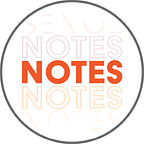Introducing: Notes on Notes
+Bonus Collab: Love in the Time of Corona • 12 June 2020
Introducing Notes on Notes: A listening exchange series. One collaborator provides a playlist, another responds by sharing (and commenting on) a selection of non-musical pairings. This series explores the playlist as a work in its own right, alongside and equal to other media and genres.
Instigated by Pranathi Diwakar, playlist whisperer and sociologist, and Josh Babcock, textual bricoleur and anthropologist.
We’ll post new content on the 2nd Friday of each month.
The series draws inspiration from many sources. The concept is inspired by a special October 2015 session of the U.S. Locations Workshop (Chicago), “Untitled: A Dark Side Mixtape,” by Kristen Simmons and Kaya Williams, with support from Owen Kohl and Molly Cunningham (then, all PhD students in Anthropology at the University of Chicago). The format is inspired by A Weekend Monthly by A Weekend Affair (Singapore) and TheoryFilm Sessions by Bras Basah: Open School of Theory and Philosophy (Singapore). The name is inspired by a musical composition workshop organized by The Madhatter Project (Singapore).
Bonus Collab: Love in the Time of Corona
Listen: spoti.fi/2zraS5T
Playlist by Pranathi: With the world shifting right under our feet, I have found real comfort in the warm padding of my headphones, shielding me from a world that threatens to overwhelm the instant that the music stops. I have always used music as a coping mechanism — opting to make a playlist instead of confronting a looming deadline. There is solace in devoting myself to the transitions, the mood, and the overall effect of the tunes sequenced to really connect with my imagined listener (hi mom!).
At the beginning of the pandemic, I made this playlist called “Love in the Time of Corona,” a very original moniker inspired by the Marquez novel that I cherished back in college and had little to do with a pandemic. The playlist is a mix of tunes drawing from a variety of genres (what are “genres” anyway?), and spanning a range of emotions intended to help the listener lean in or out of pandemic-induced existential dread. The tunes on the playlist go from mellow to downright dolorous and then pick back up again to get you bopping, and maybe — just maybe — you will feel that in the 3-ish hours that you occupy this sonic world, you are not alone. Someone has listened to those tunes before, they will listen to them again, and maybe they will leave a lingering bar or groove in your memory that prompt a feeling of tenderness towards yourself when you think back on this time in the future, remembering how you pulled through after all.
I posted this playlist on my social media on 13 March 2020, before we realized the seriousness of what we will be left confronting for the near future. I am often too shy to share my playlists, but when I did share this playlist, acquaintances began to reach out to say that the playlist had meant something to them. With this tiny boost of encouragement, I have now decided that playlists are my love language, my panacea, and my full-time job. Maybe music can plug the silences that words cannot fill, as we learn how to relate to one another again in the context of a transformed world. Maybe music will help us make new friends who are also seeking succor from the turbulence outside. Maybe music will teach us that it is okay to feel our feelings, because what else are we going to do with all this time on our hands?
Response from Josh: At first, songs with “heartbreak” and “fever” as lyrical metaphors take on vaguely sinister overtones for me in this moment of global pandemic. Yet the playlist’s eclectic, chill vibes feel like a meditative reminder against aimless panic. Its directive: breathe. As breath is threatened by viral respiratory infection and routine acts of state-perpetrated, state-sanctioned White terror and murder against Black and Indigenous people in the U.S. — as we remember the murders of Ahmaud Arbery, Breonna Taylor, George Floyd, and countless others — I remember that breathing is always political.
Notes on Pairings: Philosopher Adriana Cavarero’s 2005 book offers a technical overview of the role of “breath” in the philosophy of Emmanuel Levinas. For Levinas, “breathing” is fundamental to acts of “communication”:
“Nothing more than the act of breathing is able to testify to the proximity of human beings to one another; nothing else better confirms their communication as a reciprocal exposure that precedes any initiative. Breathing. For breathing is…a profound communication of oneself, an exchange in which one inhales the air that the other exhales” (Cavarero 2005, 31).
Cavarero’s philosophy of voice is not my main interest, nor is her extension of Levinas’ philosophy (though I’m linking to the text for anyone who is interested). Instead, I take this as a profound reminder that breathing — while individual — is always intersubjective, and is thus inescapably tied to ethics.
Read Here: Cavarero, Adriana (2005[2003]). For More than One Voice: Toward a Philosophy of Vocal Expression. Translated by Paul A. Kottman. Stanford: Stanford University Press.
Images by Josh Babcock (top) and Ryan McGuire from Pixabay (below).
